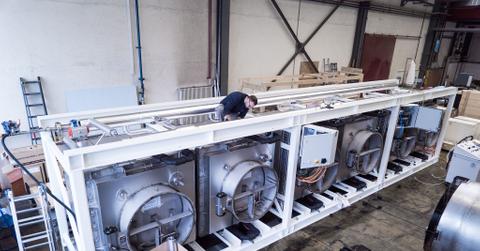Startup Captures And Recycles Carbon Emissions With Shipping Containers
Climeworks is the company behind the Direct Air Capture plant, which sucks up carbon dioxide emissions already in the air. It's then sold to other companies that can use that captured CO2 for growing plants and creating beverages.
Updated May 24 2019, 12:04 a.m. ET
Transitioning to an economy that emits less carbon will help keep the global temperature from rising at a rapid rate, but there’s a team hoping to literally suck the emissions out of the air. A carbon capture machine sits atop of a waste neutralizing facility in Zurich and does just that. Then, the collected carbon dioxide is sold to places that need it to grow plants or create beverages.
The startup behind the CO2 collection is Climeworks, and their product is featured on a waste management plant in Zurich, Switzerland. Six units are placed in each of the three repurposed shipping containers. Sponge filters inside of the machine collect the carbon dioxide in the air, and it takes roughly two to three hours to complete this process.
When the sponges are filled, the box closes and is heated up to 212 degrees Fahrenheit. By doing this, the captured CO2 converts into a regenerated form that’s valuable in a few different situations. For example, a plant can be used to create the carbonation of soda or beer, packaged in fresh meat and vegetables to preserve quality, and it can be funneled into greenhouses to help plants thrive.
“It’s a cyclic process,” Jan Wurzbacher, a co-founder of Climeworks, tells Fast Company. “You saturate with CO2, then you regenerate, saturate, regenerate. You have multiple of these units, and not all of them go in parallel. Some are taking in CO2, some are releasing CO2. That means that overall the plant has continuous CO2 production, which is also important for the customer.”
The first commercial Direct Air Capture plant was first unveiled back at the end of May on the Swiss waste management facility. Initially, it’ll be shipping out 900 metric tons of CO2 emissions to a local greenhouse. There isn’t a true retail price on carbon emissions, but they expect to work with corporations that fall under the same view of protecting the environment.
Ultimately, the company is hoping to capture one percent of worldwide carbon emissions by 2025. This will be achieved as they create more of their machines, but Wurzbacher admitted that cost in production will have to decrease in order to make it viable. Adding renewable energy sources to fuel the heat and increasing the efficiency of the technology will also help in completely removing the carbon footprint.
Climeworks argues that simply transitioning to a better environment won’t be enough. As we know, switching over to electric vehicles will be long process. There aren’t any current solutions in terms of taking out fossil fuels in air travel and shipping products around the world. Even if the economy switches in an optimum setting, this will “only reduce CO2 by around 80 percent,” according to the company’s website.
